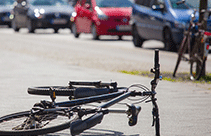This litigation has concluded and we are proud to report that our clients' claims have been successfully resolved. The amounts of all individual client recoveries are confidential, both by settlement agreement and by attorney-client privilege. MLG is no longer accepting cases involving this product.
Published on Wednesday, May 4, 2016 by Amos Brumble

This is the most common cause of car/bike accidents for road cyclists. This can happen in situations where there is no flow of traffic other than you and the driver making the turn or in situations where you can be hidden by cars traveling in the same direction as you.
The best defense is to see the potential for a problem ahead of time and to anticipate the need for defensive maneuvering.
With any of these, alone or in combination, it's smart to assume the driver is going to be making a turn across your pathway and that he/she has not seen you.
First and foremost, try to safely make yourself visible to the oncoming driver. In all conditions, day or night, a bright headlight will be helpful in making you more visible to drivers. Ideally a bar mounted light and a helmet mounted light so that you can direct the light at the oncoming driver alerting him/her to your presence. Bright colored clothing can also be helpful but lights are generally more effective.
A second good option is to ride far enough out into the road to be seen. Two to three feet from the curb helps. Riding very close to the side of the road has a number of disadvantages, the principal one is that it makes it harder for the driver to see you. Check behind you to see if there is a break in oncoming traffic that will allow you to move slightly into the break to help the driver notice you. This also gives you more room to maneuver defensively if you need to do so. Once you pass the situation move back to your normal riding position.
Assuming you did everything to avoid an accident but the driver has turned and it is eminent that you will collide with the car? There are only two good options once the driver has turned.
Next up, Drivers passing you from behind.
This litigation has concluded and we are proud to report that our clients' claims have been successfully resolved. The amounts of all individual client recoveries are confidential, both by settlement agreement and by attorney-client privilege. MLG is no longer accepting cases involving this product.